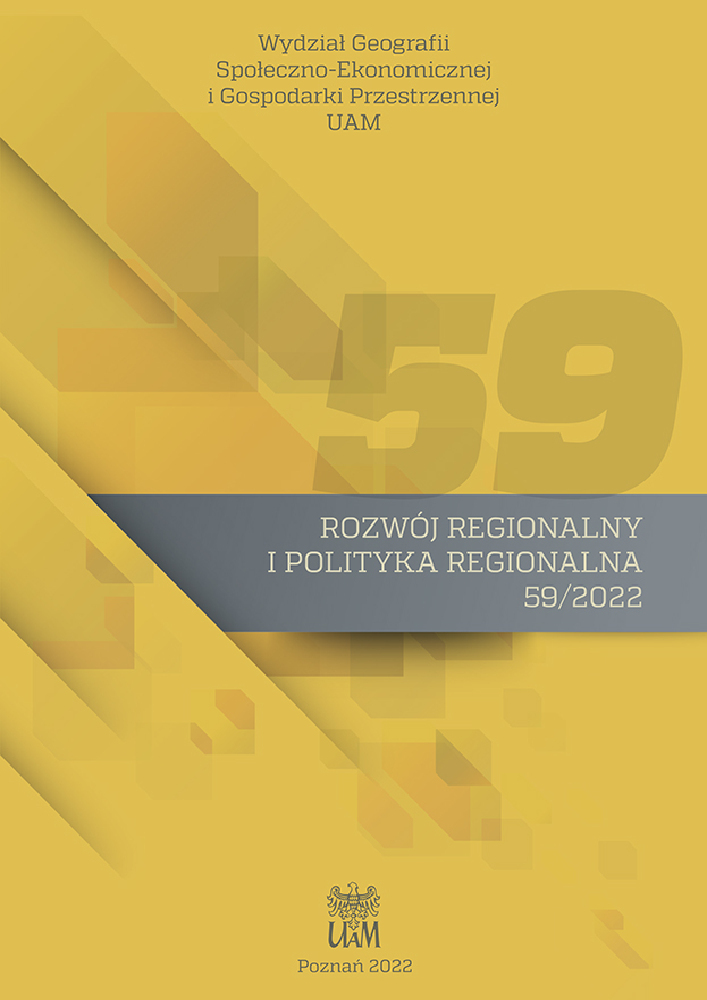Abstract
Measures taken to minimize the impact of the COVID-19 pandemic on the economy involved spending public funds in a different way than was planned in the budgets of public sector units. National and local governments around the world introduced measures to limit the spread of the virus, translating, among other things, into restrictions on the activities of economic entities. This situation has resulted, on the one hand, in a reduction of both tax and fee revenues and other public and legal charges not only to the state budget, but also to the various levels of territorial sector units, and, on the other hand, in increased spending by these institutions.
It has become a common opinion that the pandemic has affected the financial condition of local government units, but there is a lack of analysis in the literature at the level of provinces, which are financed differently than the municipal level in Poland. This study aimed to assess the impact of the COVID-19 pandemic on the financial condition of local government provinces in Poland as depicted by fundamental budget indicators. The analysis showed that based on indicators that, according to theory, should describe the financial situation of territorial sector units, in emergency situations such as the COVID-19 pandemic, do not reflect the actual picture. Our considerations indicate that certain theoretical assumptions are not suitable for “difficult times”. If one were to base only on numbers and theory, one would be led to the erroneous conclusion that the pandemic did not financially affect territorial sector units at the regional (provincial) level.
References
Adamczyk A., Dawidowicz D. 2016. Wartość informacyjna wskaźników oceny kondycji finansowej jednostek samorządu terytorialnego. Ekonomiczne Problemy Usług, 25: 25-36 (https://doi.org/10.18276/epu.2016.125-02). DOI: https://doi.org/10.18276/epu.2016.125-02
Addas A., Maghrabi A. 2021. The Impact of COVID-19 Lockdowns on Air Quality – A Global Review. Sustainability, 13(18): 10212 (https://doi.org/10.3390/su131810212). DOI: https://doi.org/10.3390/su131810212
Brinca P., Duarte J.B., Faria-e-Castro M. 2021. Measuring labor supply and demand shocks during COVID-19. European Economic Review, 139: 103901 (https://doi.org/10.1016/j.euroecorev.2021.103901). DOI: https://doi.org/10.1016/j.euroecorev.2021.103901
Chudik A., Mohaddes K., Pesaran M.H., Raissi M., Rebucci A. 2020. Economic consequences of Covid-19: A counterfactual multi-country analysis. VoxEU.org. https://doi.org/10.24149/gwp402 DOI: https://doi.org/10.24149/gwp402
del Rio-Chanona P., Mealy R.M., Pichler A., Lafond F., Farmer D.F. 2020. Supply and demand shocks in the COVID-19 pandemic: An industry and… COVID Economics Vetted and Real-Time Papers, Centre for Economic Policy Research Press, 6 (https://www.inet.ox.ac.uk/publications/supply-and-demand-shocks-in-the-covid-19-pandemic/). DOI: https://doi.org/10.1093/oxrep/graa033
Dougherty S., Biase P. de 2021. State and local government finances in the time of COVID-19. VoxEU.org. (https://voxeu.org/article/state-and-local-government-finances-time-covid-19).
Dougherty S., de Biase P. 2021. Who absorbs the shock? An analysis of the fiscal impact of the COVID-19 crisis on different levels of government. International Economics and Economic Policy, 18(3): 517-540 (https://doi.org/10.1007/s10368-021-00518-1). DOI: https://doi.org/10.1007/s10368-021-00518-1
Dworakowska M. (2018). Dochody budżetowe jednostek samorządu terytorialnego z perspektywy absorpcji funduszy unijnych. Optimum. Economic Studies, 3(93): 51-62 (https://doi.org/10.15290/oes.2018.03.93.05). DOI: https://doi.org/10.15290/oes.2018.03.93.05
Dylewski M., Filipiak B., Gorzałczyńska-Koczkodaj M. 2011. Analiza finansowa budżetów jednostek samorządu terytorialnego. Municipium.
Filipiak B. (red.) 2009. Metodyka kompleksowej oceny gospodarki finansowej jednostki samorządu terytorialnego. Difin.
Filipiak B.Z. 2018. Indywidualny wskaźnik zadłużenia jako determinanta oceny kondycji finansowej jednostki samorządu terytorialnego. Nierówności Społeczne a Wzrost Gospodarczy, 56(4): 73-86 (https://doi.org/10.15584/nsawg.2018.4.6). DOI: https://doi.org/10.15584/nsawg.2018.4.6
Haleem A., Javaid M., Rab S. 2020. Impact of additive manufacturing in different areas of Industry 4.0. International Journal of Logistics Systems and Management, 37(2): 225-238 (https://doi.org/10.1504/IJLSM.2020.110578). DOI: https://doi.org/10.1504/IJLSM.2020.110578
Jastrzębska M. 2012. Finanse jednostek samorządu terytorialnego. Wolters Kluwer.
Kochanov P., Hong Y., Mutambatsere E. 2020. COVID-19’s Impact on Sub-National Governments. International Finance Corporation World Bank Group (https://www.ifc.org/wps/wcm/connect/Industry_EXT_Content/IFC_External_Corporate_Site/Infrastructure/Resources/COVID-19+Impact+on+Sub-National+Governments).
Kopyściański T., Rólczyński T. 2014. Analiza wskaźników opisujących sytuację finansową powiatów w województwie dolnośląskim w latach 2006-2012. Studia Ekonomiczne, 206: 61-73.
Kotowska E. 2016. Przesłanki racjonalnej polityki budżetowej w jednostkach samorządu terytorialnego. [W:] A. Gołębiowska, P.B. Zientarski (red.), Funkcjonowanie samorządu terytorialnego – uwarunkowania prawne i społeczne. Kancelaria Senatu RP.
Kwaśny J. 2017. Kondycja finansowa wybranych jednostek samorządu terytorialnego województwa małopolskiego w nowej perspektywie finansowej Unii Europejskiej. Nierówności Społeczne a Wzrost Gospodarczy, 49(1): 228-250 (https://doi.org/10.15584/nsawg.2017.1.18). DOI: https://doi.org/10.15584/nsawg.2017.1.18
Misiąg W. 2020. Impact of the COVID-19 pandemic on Polish public finances – sources of financing, expenses, procedures (https://www.repozytorium.uni.wroc.pl/dlibra/publication/135760/edition/128527).
Mrówczyńska-Kamińska A., Kucharczyk A., Średzińska J. 2011. Analiza finansowa w jednostkach samorządu terytorialnego na przykładzie miasta i gminy Środa Wlkp. Zeszyty Naukowe Szkoły Głównej Gospodarstwa Wiejskiego. Ekonomika i Organizacja Gospodarki Żywnościowej, 89 (http://yadda.icm.edu.pl/yadda/element/bwmeta1.element.agro-b7ee59fd-e724-4c90-be30-d5983b8215b3).
Natrini N.D., Taufiq Ritonga I. 2017. Design and Analysis of Financial Condition Local Government Java and Bali (2013-2014). SHS Web of Conferences, 34: 03003 (https://doi.org/10.1051/shsconf/20173403003). DOI: https://doi.org/10.1051/shsconf/20173403003
OECD 2020. The impact of the COVID-19 crisis on regional and local governments: Main findings from the joint CoR-OECD survey. OECD (https://doi.org/10.1787/fb952497-en).
Rozporządzenie Ministra Finansów w sprawie sposobu prowadzenia gospodarki finansowej jednostek budżetowych i samorządowych zakładów budżetowych (Dz.U. z 2019 r., poz. 1718).
Staszel A. 2016. Narzędzia analizy finansowej w jednostkach samorządu terytorialnego. Zeszyty Naukowe Uniwersytetu Ekonomicznego w Krakowie, 10(958): 65-80 (https://doi.org/10.15678/ZNUEK.2016.0958.1005). DOI: https://doi.org/10.15678/ZNUEK.2016.0958.1005
Swianiewicz P., Łukomska J. 2020. Finanse samorządu terytorialnego w dobie pandemii. forumldei, 14.
Szołno-Koguc J. 2006. Wybrane wskaźniki kondycji finansowej jednostek samorządu terytorialnego. [W:] B. Filipiak, A. Szewczuk (red.), Samorząd terytorialny w zintegrowanej Europie (https://scholar.google.pl/citations?view_op=view_citation&hl=pl&user=dr_tQtEAAAAJ&citation_for_view=dr_tQtEAAAAJ:9yKSN-GCB0IC).
Ustawa z dnia 12 stycznia 1991 r. o podatkach i opłatach lokalnych (Dz.U. z 2022 r., poz. 1452).
Ustawa z dnia 13 listopada 2003 r. o dochodach jednostek samorządu terytorialnego (Dz.U. z 2021 r., poz. 1672, 1901, 1927).
Ustawa z dnia 27 sierpnia 2009 r. o finansach publicznych (Dz.U. z 2021 r., poz. 305, 1236, 1535, 1773, 1927, 1981).
Wiśniewski M. 2011. Wyznaczniki sytuacji finansowej gminy. Ocena istotności za pomocą analizy skupień. Prace Naukowe Uniwersytetu Ekonomicznego we Wrocławiu. Nauki o Finansach, 9(215): 110-119.
Zawora J. 2015. Analiza wskaźnikowa w procesie zarządzania finansami samorządowymi. Zarządzanie Finansami i Rachunkowość/Szkoła Główna Gospodarstwa Wiejskiego w Warszawie, 4: 33-45.
License
Copyright (c) 2022 Elżbieta Ociepa-Kicińska, Małgorzata Gorzałczyńska-Koczkodaj, Krystyna Brzozowska, Przemysław Pluskota

This work is licensed under a Creative Commons Attribution 4.0 International License.

